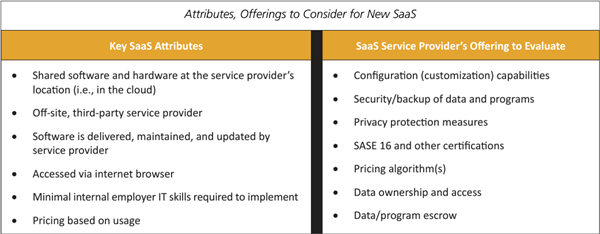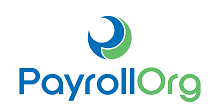SaaS From the Payroll Perspective

Today, most of our personal and professional interactions with technology involve some aspects of a software-as-a-service (SaaS) offering, from ordering fast food to collaborating with coworkers on documents. Here, we will focus on SaaS applications that are more specific to payroll.
The Payroll Source® definition of SaaS is “delivering a business function, such as payroll, via cloud computing” (see §12.8-4). It also lists key SaaS attributes and service provider offerings to consider if planning to implement a new payroll SaaS (see figure below).
Many organizations have moved to payroll SaaS service providers over recent years, contributing to a growing knowledge base of characteristics often encountered during successful SaaS implementations. Internal and external pressures play a part in most projects. These pressures can vary across industries or be specific to a particular company. The project team members’ preparedness and ability to address challenges will contribute to the success of the implementation.
While being a part of a successful implementation is a rewarding experience, some project results have not met expectations. A SaaS implementation can significantly impact a payroll department’s ability to perform its core functions, such as accurate and timely payments and adhering to regulatory compliance and reporting. However, an engaged, collaborative, and vocal payroll department can position itself to influence project leadership and set the stage for using the SaaS service provider’s capabilities and offerings the best after the project competition. While understanding that payroll department functions and staffing models differ across companies, the following focus points can help work towards being an engaged, collaborative, and vocal payroll department and project contributor.
Early Involvement Providing a voice for the payroll department in conversations before the SaaS project becomes “official” is crucial. The group of people involved in early discussions regarding the status of current human capital management (HCM)/payroll software is often limited. However, working with your leadership can help bring awareness to the current software’s ability to serve the organization’s payroll requirements and determine if there is an urgency to migrate from the current software. For example, the current payroll software vendor may plan to increase costs or eliminate regulatory support for your version. Alternatively, your company may have had an acquisition and outgrown the current software capabilities.
Leadership, whose responsibilities are broad and include a variety of divisions, has less direct visibility into payroll’s operations, which emphasizes the payroll department’s need to be able to represent payroll directly or through their leadership.
When possible, payroll leadership should be aware of the organization’s future vision in the short term and the long term. For example, suppose the company plans to expand into multiple states in the next year. In that case, payroll can determine the direct impacts on their department, such as staffing levels and state and local compliance. If an organization plans to redistribute responsibilities or resize other departments, payroll leadership can voice any indirect impacts to the payroll department and identify possible business processes.

Leveraging material from different sources is a good practice while conducting research. PayrollOrg has a wealth of information to help start the research process. Below is a sample of some documents currently available, right from PAYTECH:
Collaborating with other functional areas in the SaaS project is essential when gathering business requirements for implementation. For example, if a SaaS implementation includes a subset of HCM (HR, compensation, benefits, and payroll), collaborating with the other functional areas is an opportunity to understand the functionality vital to them and their SaaS expectations. Collaboration can also result in new business requirements based on a better understanding of functionality that other areas plan to leverage in SaaS.
A SaaS implementation allows the payroll department to eliminate unnecessary complexity. The ideal approach is to adopt the SaaS-delivered functionality and business processes. However, there are valid instances where personalization or customization is required to satisfy a requirement. Certain SaaS providers offer this capability, which may be essential when voicing payroll requirements.
Finally, a payroll department that is engaged and collaborative will be a valuable participant during the SaaS implementation and set the stage for best utilizing the SaaS service provider’s capabilities and offerings after the project completion.
The Payroll Source® definition of SaaS is “delivering a business function, such as payroll, via cloud computing” (see §12.8-4). It also lists key SaaS attributes and service provider offerings to consider if planning to implement a new payroll SaaS (see figure below).
Many organizations have moved to payroll SaaS service providers over recent years, contributing to a growing knowledge base of characteristics often encountered during successful SaaS implementations. Internal and external pressures play a part in most projects. These pressures can vary across industries or be specific to a particular company. The project team members’ preparedness and ability to address challenges will contribute to the success of the implementation.
While being a part of a successful implementation is a rewarding experience, some project results have not met expectations. A SaaS implementation can significantly impact a payroll department’s ability to perform its core functions, such as accurate and timely payments and adhering to regulatory compliance and reporting. However, an engaged, collaborative, and vocal payroll department can position itself to influence project leadership and set the stage for using the SaaS service provider’s capabilities and offerings the best after the project competition. While understanding that payroll department functions and staffing models differ across companies, the following focus points can help work towards being an engaged, collaborative, and vocal payroll department and project contributor.
Early Involvement Providing a voice for the payroll department in conversations before the SaaS project becomes “official” is crucial. The group of people involved in early discussions regarding the status of current human capital management (HCM)/payroll software is often limited. However, working with your leadership can help bring awareness to the current software’s ability to serve the organization’s payroll requirements and determine if there is an urgency to migrate from the current software. For example, the current payroll software vendor may plan to increase costs or eliminate regulatory support for your version. Alternatively, your company may have had an acquisition and outgrown the current software capabilities.
Leadership, whose responsibilities are broad and include a variety of divisions, has less direct visibility into payroll’s operations, which emphasizes the payroll department’s need to be able to represent payroll directly or through their leadership.
When possible, payroll leadership should be aware of the organization’s future vision in the short term and the long term. For example, suppose the company plans to expand into multiple states in the next year. In that case, payroll can determine the direct impacts on their department, such as staffing levels and state and local compliance. If an organization plans to redistribute responsibilities or resize other departments, payroll leadership can voice any indirect impacts to the payroll department and identify possible business processes.

Research SaaS Providers
Researching the different SaaS service providers and their capabilities is critical before settling on a SaaS service provider. A company, for instance, may want to move more than just payroll to SaaS. For example, one company may implement SaaS for HCM functions such as HR, benefits, time and labor (T&L), and payroll, while a different company may implement HCM, finance, and supply chain simultaneously.Leveraging material from different sources is a good practice while conducting research. PayrollOrg has a wealth of information to help start the research process. Below is a sample of some documents currently available, right from PAYTECH:
- Payroll Solutions Directory (December issues)
- Workforce Management Buyer’s Guide (October issues)
- HRIS Buyer’s Guide (November issues)
- Cloud-Based Solutions Buyer’s Guide (last ran in June 2022 issue)
- Global Payroll Buyer’s Guide/Directory (May issues)
Business Requirements
Defining business requirements is a critical task. The payroll department should actively contribute to the requirements-gathering process. Payroll leadership could treat the business requirements as a keystone task that ties together the efforts as previously mentioned. The payroll department should have the most comprehensive understanding of the functionality required for completing tasks from a daily, monthly, quarterly, and annual perspective for both the present and future vision.Collaborating with other functional areas in the SaaS project is essential when gathering business requirements for implementation. For example, if a SaaS implementation includes a subset of HCM (HR, compensation, benefits, and payroll), collaborating with the other functional areas is an opportunity to understand the functionality vital to them and their SaaS expectations. Collaboration can also result in new business requirements based on a better understanding of functionality that other areas plan to leverage in SaaS.
Eliminate Complexity in SaaS
For decades, payroll departments have been required to accommodate increased legislative complexity at the federal, state, and local levels. An important task is identifying the requirements driving current business practices. Ideally, business requirements can be traced to the company’s policies. However, in the past, payroll may have developed a less-than-optimal procedure to accommodate the software’s ability to address a legal complexity.A SaaS implementation allows the payroll department to eliminate unnecessary complexity. The ideal approach is to adopt the SaaS-delivered functionality and business processes. However, there are valid instances where personalization or customization is required to satisfy a requirement. Certain SaaS providers offer this capability, which may be essential when voicing payroll requirements.
Finally, a payroll department that is engaged and collaborative will be a valuable participant during the SaaS implementation and set the stage for best utilizing the SaaS service provider’s capabilities and offerings after the project completion.
